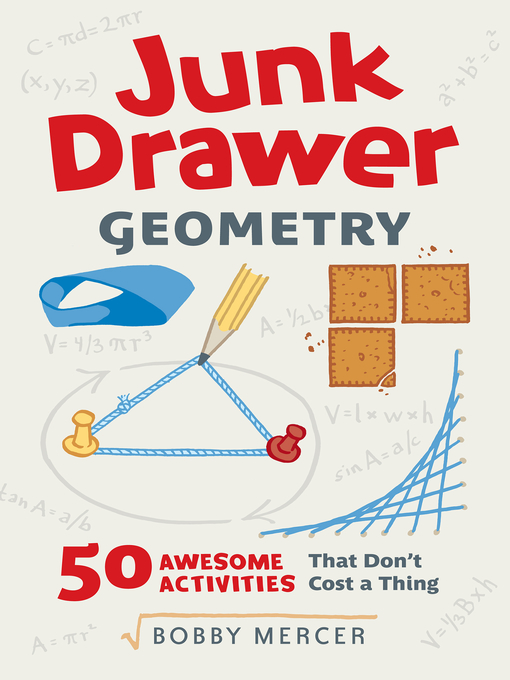- All Magazines
- Popular Magazines: Always Available
- Cooking and Food Magazines
- Craft Magazines
- News and Politics
- See all magazines collections
Junk Drawer Geometry
50 Awesome Activities That Don't Cost a Thing
Each of this book's 50 creative geometry projects includes a materials list and detailed, step-by-step instructions with illustrations. The projects also include ideas on how to modify the lessons for different age and skill levels, allowing anyone teaching children to use this to excite students. Educators and parents will find this title a handy guide to teach problem-solving skills and applied geometry, all while having a lot of fun.
-
Creators
-
Series
-
Publisher
-
Release date
October 2, 2018 -
Formats
-
Kindle Book
-
OverDrive Read
- ISBN: 9780912777818
-
EPUB ebook
- ISBN: 9780912777818
- File size: 7442 KB
-
-
Languages
- English
-
Reviews
-
Booklist
December 1, 2018
Grades 4-8 Kids who hate geometry may change their minds after trying the activities in this entry in the Junk Drawer Science series. The author, a physics teacher, understands that kids will grasp geometry more easily if they can visualize it with concrete examples. If younger kids are exposed to geometry concepts before they're taught in school, he says, the easier it will be for them to understand as they get older. The 50 included activities use no- or low-cost materials to demonstrate geometry concepts: learning the Pythagorean theorem with cheese crackers, or comparing area to perimeter using wheat crackers. Each activity includes step-by-step instructions and black-and-white photos, and indicates what grades it's geared for, while suggesting ways to adapt for younger or older students. The activities range from advanced ones for high-schoolers to those for younger kids (i.e., how to create a flip-art book of shapes). This entertaining and instructional book is ideal for students studying geometry, exploring STEM careers, or those who just love solving math puzzles.(Reprinted with permission of Booklist, copyright 2018, American Library Association.) -
School Library Journal
December 21, 2018
Gr 5 Up-Mercer, an experienced physics teacher, presents simple projects in this accessible volume. The introduction provides a succinct rationale for using hands-on activities to help students master math and science concepts. The volume is divided into three sections, each with 14-18 examples. In "Geometry Tools," students make cereal box calipers, a paper protractor, and yarn and cardboard graph paper. In "Math Labs," students see real-world applications to geometry concepts as they work through projects such as cheese cracker Pythagoras and midsegment toilet paper. In "Fun Geometry Activities," students make their own tessellations and puzzles. Each craft includes a brief description, a list of supplies, an explanation of the math concepts learned, and information on which grade levels the project is for, from elementary to high school. Step-by-step directions are comprehensible and accompanied by useful photos. The titular phrase "Junk drawer geometry" is right on-all materials are inexpensive and easy to gather. VERDICT A great addition to STEM collections and makerspaces.-Erica Thorsen, Albemarle High School, VA
Copyright 1 School Library Journal, LLC Used with permission.
-
Formats
- Kindle Book
- OverDrive Read
- EPUB ebook
subjects
Languages
- English
Loading
Why is availability limited?
×Availability can change throughout the month based on the library's budget. You can still place a hold on the title, and your hold will be automatically filled as soon as the title is available again.
The Kindle Book format for this title is not supported on:
×Read-along ebook
×The OverDrive Read format of this ebook has professional narration that plays while you read in your browser. Learn more here.


